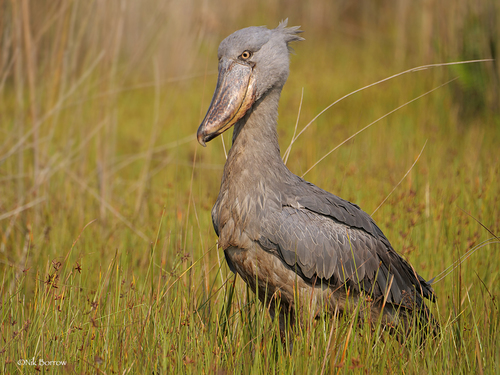
Shoebill
The Shoebill (Balaeniceps rex) is a large, distinctive bird found in the swamps and marshes of East Africa. It is renowned for its massive, shoe-shaped bill, which it uses to hunt lungfish and other aquatic prey. This unique bird plays a critical role in its wetland ecosystem as a top predator. It holds cultural significance in some regions and is often a symbol of these fragile environments. The Shoebill's unique appearance and behavior make it a subject of fascination for birdwatchers and biologists alike.
110-140 cm
Length
230-260 cm
Wingspan
Vulnerable
Conservation Status
Distribution
The Shoebill is found in eastern Africa, from South Sudan and Uganda south to Zambia. It is primarily non-migratory, but may make local movements in response to water levels and food availability. It is typically found at lower altitudes, particularly in extensive freshwater swamps.
Lifespan
Up to 35 years in the wild; up to 50 years or more in captivity.
Shoebill's Habitat
Habitat Types
Freshwater swamps, Marshes, Flooded grasslands, Areas with dense aquatic vegetation
Climate Zones
Tropical
Adaptations
The Shoebill's large feet and long legs are adapted for wading in deep water and moving through dense vegetation. Its most striking adaptation is its large bill, equipped with sharp edges and a hooked tip, perfect for catching and handling slippery prey.
Variations
No recognized subspecies exist; the Shoebill is considered a monotypic species.
Appearance
Breeding Plumage
Plumage remains relatively consistent throughout the year.
Seasonal Feather Changes
No significant seasonal variation.
Sex Based Plumage Differences
Minimal; males and females have similar plumage.
Notable Features
Massive, shoe-shaped bill, Gray plumage, Long legs, Large feet, Yellow eyes
Diet and Feeding
Primary Foods
Lungfish, Tilapia, Catfish, Frogs, Water snakes, Occasionally young crocodiles or turtles
Foraging Behavior
The Shoebill is a patient hunter, often standing motionless for long periods before ambushing prey with a sudden, lightning-fast strike. It uses its large bill to scoop up fish and other animals from the water.
Specializations
The sharp edges and hooked tip of the bill are specialized for capturing and holding slippery prey. The bird often decapitates larger fish before swallowing them.
Seasonal Diet Variations
Diet may vary slightly depending on prey availability, but lungfish remain a staple food source throughout the year.
Behavior
Social Structure
Generally solitary, except during the breeding season when pairs form.
Communication
Bill-clattering (especially during courtship), Low croaking sounds, Head bobbing
Migration
Primarily non-migratory, but may make local movements in response to changing water conditions.
Territorial or Group Behaviors
Highly territorial during breeding, defending their nesting area from intruders. Outside of breeding, they are generally solitary and do not form flocks.
Conservation
Threats
Habitat destruction (due to agriculture, drainage, and burning), Human disturbance, Hunting (for food or trade), Nest destruction by livestock
Protection Programs
Protected areas within its range (e.g., national parks and reserves), Community-based conservation initiatives, Research and monitoring programs
Local National Laws
Protected under national legislation in several countries within its range.
Population Trend
Decreasing
Population Estimates
Estimated 3,300 to 5,300 mature individuals.
Interesting Facts
The Shoebill was only described to Western science in the 19th century.
Despite its large size and distinctive appearance, it remained relatively unknown outside of its African habitat until relatively recently.
They are sometimes referred to as 'whale-headed storks'.
This name refers to the shape of their bill, although they are not closely related to storks.
Shoebills can stand motionless for hours.
This incredible patience is a key part of their hunting strategy.
They are considered one of the most sought-after birds by birdwatchers in Africa.
Their unique appearance and elusive nature make them a prized sighting.
Faqs about Shoebill
What is the Shoebill's closest relative?
Genetic studies suggest that the Shoebill's closest relatives are pelicans.
Why is the Shoebill's bill so large?
The large bill is an adaptation for hunting lungfish and other prey in dense, muddy swamps.
Are Shoebills dangerous to humans?
Shoebills are not typically aggressive towards humans, but they can be defensive if their nest or young are threatened. It's best to observe them from a safe distance.
How many eggs does a Shoebill lay?
They typically lay 1-3 eggs, but due to siblicide (the killing of a sibling), often only one chick survives to adulthood.
Copyright @ Nature Style Limited. All Rights Reserved.
 English
English